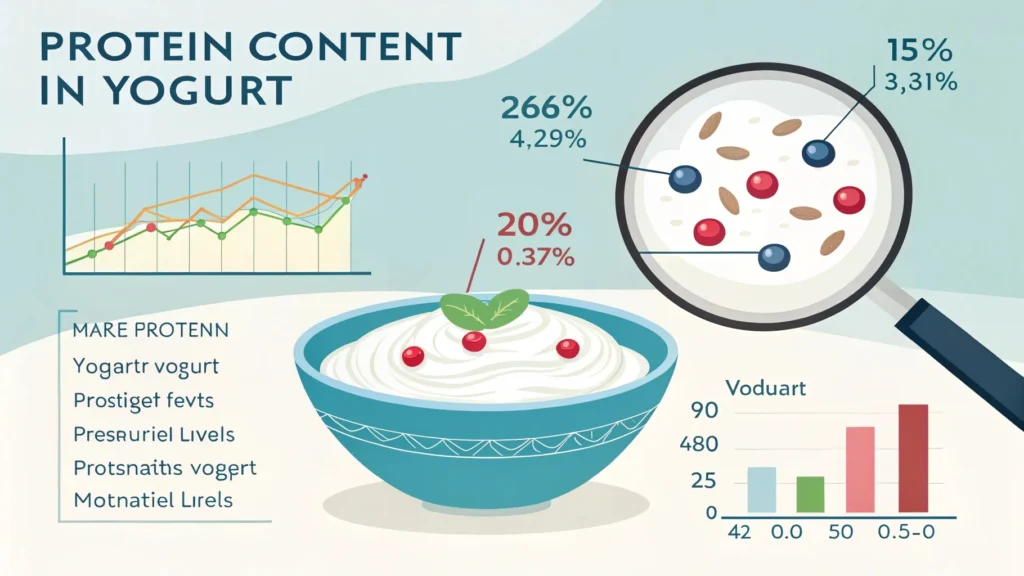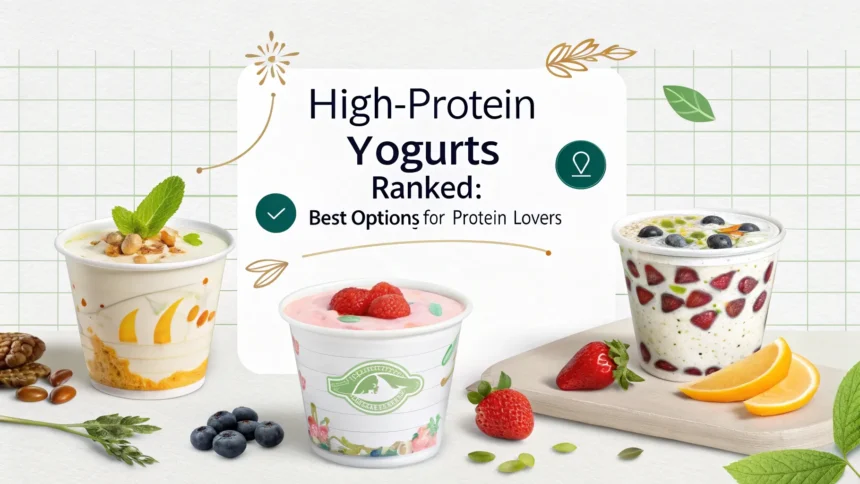In today’s health-conscious world, high-protein yogurt has become a favorite among fitness enthusiasts and everyday snackers alike. These creamy treats provide a delicious way to boost your protein intake, making them an ideal option for anyone looking to enhance their diet. In this article, we will explore the best high-protein yogurts available, their nutritional benefits, and tips on how to choose the right one for your needs.
What is High-Protein Yogurt and Why is it Popular?
Understanding the Protein Content in Yogurt
High-protein yogurt is a dairy product that has been specifically formulated to contain more protein than traditional yogurt varieties. These yogurts typically boast protein content ranging from 15 grams to as much as 20 grams of protein per serving.

This makes them an excellent choice for individuals aiming to meet their daily protein requirements. The protein in these yogurts often comes from concentrated forms of milk or through the straining process, as seen in Greek yogurt, which naturally elevates the protein levels while reducing the sugar content.
Health Benefits of High-Protein Yogurt
Incorporating high-protein yogurt into your diet can offer numerous health benefits. First and foremost, protein is essential for muscle repair and growth, making these yogurts a popular snack option for athletes and gym-goers. Additionally, high-protein yogurt often contains probiotics, which are beneficial cultures that support gut health. The creamy texture of these yogurts can also aid in satiety, helping you feel fuller for longer, which is an advantage for those trying to manage their weight. Furthermore, many brands offer options with 0g added sugar, making them suitable for those looking to cut back on sugar intake.
Types of High-Protein Yogurt Available
The market for high-protein yogurt is diverse, with several types available to cater to different preferences. Greek yogurt is perhaps the most well-known, offering a thick, creamy consistency and a rich protein profile. Icelandic yogurt, or skyr, is another option that boasts even higher protein content and a slightly tart flavor. Other varieties include nonfat options, which provide a lower-calorie snack while still delivering significant protein. Furthermore, many brands are now introducing innovative blends, such as Ratio, which combines yogurt with added protein sources for an even more nutritious experience.
How to Choose the Best High-Protein Yogurt for Your Needs?
Importance of Checking Added Sugar Levels
When selecting high-protein yogurt, it’s crucial to check the label for added sugar levels. Some brands may use artificial sweeteners or include significant amounts of sugar to enhance flavor, which can negate the health benefits of the yogurt. Opting for products labeled as ‘sugar-free’ or those with 0g added sugar allows you to enjoy the taste without compromising your nutritional goals.
Comparing Nonfat vs Full-Fat Yogurt Options
Another consideration is whether to choose nonfat or full-fat yogurt. Nonfat options, such as nonfat Greek yogurt, are lower in calories and fat, making them suitable for those on a calorie-restricted diet. However, full-fat yogurts can be more satisfying and may provide beneficial fats that can help with nutrient absorption. The choice depends on your dietary needs and personal preferences, but both types can offer substantial protein content.
Evaluating Flavor and Texture Preferences
Flavor and texture are also important factors when choosing high-protein yogurt. Many brands, including Chobani, offer a variety of flavors, such as vanilla, fruit-infused, and even plain options. The texture can range from thick and creamy to lighter and more refreshing, so it’s essential to sample different types to find what you enjoy most. Some people may prefer the luxurious creaminess of Oikos Triple Zero, while others may lean towards the lighter feel of Icelandic yogurt.
What are the Top Brands of High-Protein Yogurt?
Oikos Pro: A Leader in High-Protein Yogurt
Oikos Pro has carved a niche for itself as a leading brand in the high-protein yogurt market. With its focus on delivering an impressive 20 grams of protein per serving, Oikos Pro is a favorite among fitness enthusiasts. Their yogurt cups are packed with flavor and come in convenient packaging, making them an ideal snack for on-the-go lifestyles. Additionally, Oikos Triple Zero offers a blend of protein, zero added sugar, and no artificial sweeteners, ensuring that you enjoy a guilt-free treat.
Chobani: A Popular Choice for Protein Lovers
Chobani is another prominent player in the yogurt arena, known for its commitment to quality and nutrition. Their high-protein options often feature a creamy texture and a range of flavors, including vanilla and fruit blends. With products that contain 16 grams of protein per serving, Chobani has successfully catered to the growing demand for nutritious and tasty yogurt. The brand’s emphasis on natural ingredients and minimal added sugar makes it a popular choice for those seeking to maintain a healthy lifestyle.
Ratio: Innovative Blends of Yogurt and Protein
Ratio stands out in the high-protein yogurt category with its innovative approach to combining yogurt with protein sources. Designed for those seeking to maximize their protein intake, Ratio’s products often contain around 15 grams of protein per serving without compromising on taste. Their unique blends cater to a variety of preferences, and their focus on low sugar options ensures that you can enjoy a sweet treat without the guilt.
How Does Greek Yogurt Compare to Other High-Protein Yogurts?
Protein Content Comparison: Greek vs Icelandic Yogurt
When comparing Greek yogurt to other high-protein varieties, such as Icelandic yogurt, one notable difference is the protein content. Greek yogurt typically contains around 15-20 grams of protein per serving, while Icelandic yogurt often exceeds this with 20 grams or more. This makes Icelandic yogurt a robust option for those focused on protein intake. However, Greek yogurt’s rich, creamy texture and versatility in recipes make it a preferred choice for many.

Texture and Taste Differences in Yogurts
The texture and taste of high-protein yogurts can vary significantly. Greek yogurt is known for its thick, creamy consistency, which makes it ideal for smoothies, parfaits, or as a base for sauces. In contrast, Icelandic yogurt has a slightly thinner texture while still being rich in protein. Taste-wise, Greek yogurt tends to be milder and can be easily flavored, while Icelandic yogurt often has a more pronounced tanginess, appealing to those who enjoy a bolder taste.
Usage in Recipes: Greek Yogurt Versus Others
Greek yogurt’s versatility extends beyond snacking; it can be used in various recipes, including dips, dressings, and baked goods. Its creamy nature allows it to replace higher-calorie ingredients, making it a smart choice for healthy cooking. Other high-protein yogurts, while delicious, may not lend themselves as well to certain recipes due to their texture or flavor profiles. Therefore, if you’re looking to incorporate yogurt into your meals, Greek yogurt is often the go-to option.
What are the Nutritional Profiles of High-Protein Yogurts?
Nutritional Breakdown: Oikos Triple Zero
Oikos Triple Zero is a standout example of high-protein yogurt that offers an impressive nutritional profile. Each serving contains 20 grams of protein, 0g added sugar, and is rich in probiotics, making it an excellent choice for those seeking a nutritious snack. The calorie count remains low, allowing you to indulge without exceeding your daily caloric intake. This yogurt’s combination of protein and zero sugar makes it a popular choice among health enthusiasts.
Understanding the Role of Artificial Sweeteners
Many high-protein yogurts utilize artificial sweeteners to enhance flavor without adding calories. While these sweeteners can help reduce the sugar content, it’s essential to understand their potential effects on health. Some individuals may experience digestive discomfort with certain sweeteners, and there is ongoing debate regarding their long-term impact. Therefore, when selecting high-protein yogurt, it’s wise to consider products that either use natural sweeteners or contain no sweeteners at all.
Why Zero Sugar Options are Gaining Popularity

Zero sugar options in high-protein yogurt are becoming increasingly popular as consumers become more aware of their sugar intake. These products typically contain no added sugars and are often flavored using natural fruit purees or stevia, allowing for a sweet taste without the negative health implications of sugar. As people seek out healthier snacks that align with their dietary goals, zero sugar high-protein yogurts are proving to be a satisfying and guilt-free choice.
FAQ with Terms :
Q: What is high protein yogurt?
A: High protein yogurt is a type of yogurt that contains a significant amount of protein compared to regular yogurt. Typically, these yogurts offer around 20g of protein per serving, making them an excellent choice for those looking to increase their protein intake.
Q: How does the protein ratio in high protein yogurt compare to regular yogurt?
A: The protein ratio in high protein yogurt is much higher than in regular yogurt. For example, while plain Greek yogurt may offer around 12 grams of protein per 5.3 oz serving, high protein yogurt can provide as much as 20g of protein, making it a more concentrated source of protein.
Q: Are there any brands known for high protein yogurt?
A: Yes, several manufacturers are well-known for their high protein yogurt offerings. Chobani® is one of the leading brands, offering various flavors and types of high protein yogurt, including Greek nonfat yogurt that is both flavorful and nutritious.
Q: What are the nutritional benefits of high protein yogurt?
A: High protein yogurt provides numerous nutritional benefits, including a rich source of protein, vitamins, and live and active cultures. These yogurts are often low in calories and sugar, making them a healthy option for those looking to maintain a balanced diet.
Q: Is high protein yogurt suitable for those on a keto or low carb diet?
A: Yes, many high protein yogurts are suitable for keto and low carb diets. They typically contain low amounts of sugar and carbohydrates while providing a high amount of protein, which aligns well with the dietary requirements of these lifestyles.
Q: Can I find plant-based options for high protein yogurt?
A: Yes, there are plant-based high protein yogurt options available on the market. These yogurts are made from ingredients like soy or almond milk and can offer a comparable protein content, making them suitable for vegan diets and those who are lactose intolerant.
Q: What should I look for on the label when choosing a high protein yogurt?
A: When selecting a high protein yogurt, check for the protein content, ensuring it has at least 20g of protein per serving. Also, look out for added sugars, fiber content, and the presence of live and active cultures for added health benefits.
Q: Are all high protein yogurts gluten-free?
A: Most high protein yogurts are gluten-free, particularly those made from Greek yogurt or plant-based alternatives. However, it’s essential to check the packaging for gluten-free certification if you have dietary restrictions.
Q: What is the taste like in high protein yogurt compared to regular yogurt?
A: High protein yogurt often has a thicker texture and can have a tangy flavor, especially if it’s Greek-style. Many brands also offer flavored options, such as vanilla or those containing real fruit, which can enhance the taste and sweetness without adding too much sugar.

